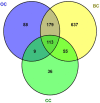Oxidative stress in female cancers
- PMID: 29805775
- PMCID: PMC5955122
- DOI: 10.18632/oncotarget.25323
Oxidative stress in female cancers
Abstract
Breast, cervical and ovarian cancers are highly prevalent in women worldwide. Environmental, hormonal and viral-related factors are especially relevant in the development of these tumors. These factors are strongly related to oxidative stress (OS) through the generation of reactive oxygen species (ROS). The OS is caused by an imbalance in the redox status of the organism and is literally defined as "an imbalance between ROS generation and its detoxification by biological system leading to impairment of damage repair by cell/tissue". The multistep progression of cancer suggests that OS is involved in cancer initiation, promotion and progression. In this review, we described the role of OS and the interplay with environmental, host and viral factors related to breast, cervical and ovarian cancers initiation, promotion and progression. In addition, the role of the natural antioxidant compound curcumin and other compounds for breast, cervical and ovarian cancers prevention/treatment is discussed.
Keywords: breast; cervical; curcumin; ovarian cancer; oxidative stress.
Conflict of interest statement
CONFLICTS OF INTEREST The authors declare no conflicts of interest
Figures

References
-
- Kruk J, Aboul-Enein HY. Reactive Oxygen and Nitrogen Species in Carcinogenesis: Implications of Oxidative Stress on the Progression and Development of Several Cancer Types. Mini Rev Med Chem. 2017;17:904–919. - PubMed
-
- Pan MH, Ho CT. Chemopreventive effects of natural dietary compounds on cancer development. Chem Soc Rev. 2008;37:2558–2574. - PubMed
-
- Pelicano H, Carney D, Huang P. ROS stress in cancer cells and therapeutic implications. Drug Resist Updat. 2004;7:97–110. - PubMed
-
- Schumacker PT. Reactive oxygen species in cancer cells: live by the sword, die by the sword. Cancer Cell. 2006;10:175–176. - PubMed
Publication types
LinkOut - more resources
Full Text Sources
Other Literature Sources

